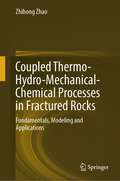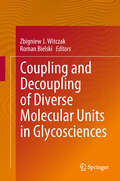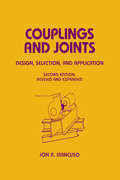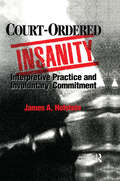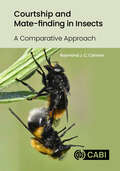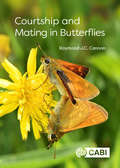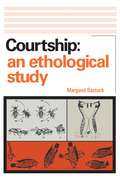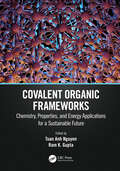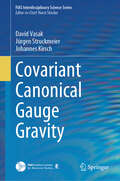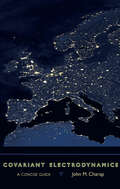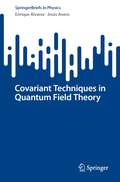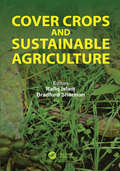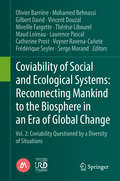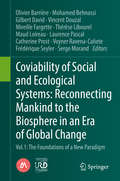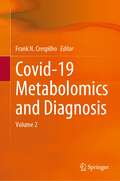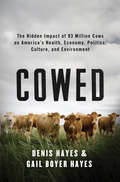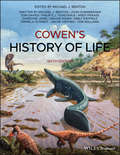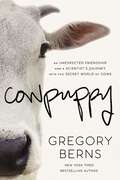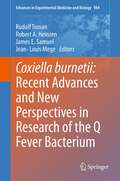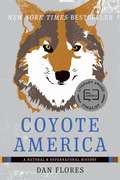- Table View
- List View
Coupled Thermo-Hydro-Mechanical-Chemical Processes in Fractured Rocks: Fundamentals, Modeling and Applications
by Zhihong ZhaoThis book presents the coupled Thermo-Hydro-Mechanical-Chemical (THMC) processes in fractured rocks at varying scales from single fractures to fracture networks. It also discussed the implication and potential application of the advanced understanding of coupled THMC processes in fractured rocks for geotechnical and geo-energy engineering.
Coupling and Decoupling of Diverse Molecular Units in Glycosciences
by Zbigniew J. Witczak Roman BielskiThis unique book covers the latest developments in coupling and decoupling of biomolecules containing functionalized carbohydrate components, being one of the first collections in this important area of applied medicinal chemistry. Connecting molecules, often referred as bio-conjugation, has become one of the most often performed procedures in modern medicinal chemistry. Sometimes, when the connected molecules are not useful anymore, they must be disconnected. The molecules that must be connected (coupled) may belong to both small and large molecules and include such constructs as glycoproteins, glycopeptides and glycans. In this work, more than 15 experts address a comprehensive range of potential and current uses of in vitro and in vivo bio-conjugation methodologies, leading to a variety of glycoconjugates. The analytical aspects of bio-conjugation are also here discussed. Medicinal and organic chemists from graduate level onwards will understand the appeal of this important book.
Couplings and Joints: Design, Selection & Application (Mechanical Engineering)
by Jon R. Mancuso"Second Edition provides new material on coupling ratings, general purpose couplings versus special purpose couplings, retrofitting of lubricated couplings to nonlubricated couplings, torsional damping couplings, torquemeter couplings, and more."
Course Lab Manual: BI 101 Worcester State University
by Mcgraw-Hill EducationConcepts of Biology Lab Manual
Court-Ordered Insanity: Interpretive Practice and Involuntary Commitment (Social Problems And Social Issues Ser.)
by James A. HolsteinThis book, about involuntary commitment proceedings, focuses on interpretive practice at the nexus of legal, psychiatric, and practical reasoning. It describes the interactional dynamics through which legally and psychiatrically warranted decisions are publicly argued, negotiated, and justified.
Courtship and Mate-finding in Insects: A Comparative Approach
by Raymond J CannonThis book explores mate-finding and courtship behaviour in the insect world, in all its subtlety and diversity. Insects engage in courtship as much, or as little, as any other animal; they have songs and dances, and all manner of instruments and ornaments to attract and court the opposite sex. Insects have evolved complex chemical and acoustic communication systems, sending fragrant messages, visual signals and subtle vibrations to attract and persuade. Insects also have many different ways and means of choosing or rejecting mating partners. This beautifully illustrated book shows the incredible variety of courtship behaviours and celebrates the wonderful natural history of a wide range of insects. Varieties of courtship can occur before, during and even after copulation, and numerous examples of the different mating strategies used are presented. As well as being fascinating and entertaining, studying courtship is also useful. For example, a knowledge of the courtship and mating behaviour of important pests helps researchers understand the dynamics of mate choice and sexual selection. Knowing which behaviours are directly related with mating success can be used to improve behaviour-based control strategies and improve sterile insect techniques. Knowledge of sex pheromones, and mating behaviour, can be combined to manage insect pests by mass or mating disruption. By studying model species - such as the fruit fly, Drosophila melanogaster - researchers have discovered how genes control and influence courtship behaviour, via proteins, biochemical pathways and neural circuits. This book integrates these diverse fields into a framework constructed around courtship and mate-finding, bringing together studies from the laboratory and the field. This landmark volume will be of interest to students of biology, entomologists, naturalists and anyone with a desire to know more about the love lives of the small creatures with which we share the planet.
Courtship and Mating in Butterflies
by Raymond J.C. CannonThis book presents a readable account of butterfly behaviour, based on field observations, great photographs and the latest research. The main focus is on courtship and mating - including perching, searching and territorial behaviour - but to understand these subjects it is necessary to explain how mates are chosen and this requires sections on wing colours and patterns. A chapter on butterfly vision is also essential in terms of how butterflies see the world and each other. There have been exciting discoveries in all of these fields in recent years, including: butterfly vision (butterfly photoreceptors), wing patterns (molecular biology), wing colouration (structural colours and nano-architecture), mating strategies and female choice (ecology and behaviour).
Courtship: An Ethological Study
by Margaret BastockThis concise but thorough study of courtship behavior in fish, birds, and arthropods is the first rigorous examination of the evolutionary origins and mechanisms of courtship and its contribution to biological success. Demonstrating the fruitfulness of an empirically based, inductive approach to understanding courtship, the book also explains clearly how principles of modern evolutionary theory can be successfully employed in studying behavior.The author describes many observations and experiments that have not previously appeared outside specialized journals and brings an abundance of simple yet accurate examples of animal behavior to bear on explanations of ethological concepts and evolutionary theory. No attempt is made to skim over the gaps of knowledge apparent in the study of behavior evolution; rather, the author discusses the limitations and difficulties of different approaches, critically reviews the deductions that can be and have been made from them, and tries to present enough evidence on controversial points for the reader himself to judge the validity of specific arguments.Indicating how ethological method, firmly based on biological principles, can intensively investigate and illuminate a single area of animal behavior, the book will be valuable to students and professionals in zoology, animal behavior, and experimental psychology.
Cousteau
by Axel MadsenOne of the most influential men of the twentieth century, Jacques Cousteau was an eco-emissary whose own life of derring-do brought him fame and the means to proselytize his cause. Ecologist, adventurer, celebrity, businessman--Cousteau was a brilliant and complex individual, and Madsen's biography captures him in style. Madsen, who knew the Cousteau family for over two decades, interviewed Cousteau personally for this book.
Covalent Organic Frameworks: Chemistry, Properties, and Energy Applications for a Sustainable Future
by Ram K. Gupta Tuan Anh NguyenCovalent organic frameworks-based nanomaterials have emerged as promising candidates for energy applications owing to their superior electrochemical properties, surface area, nano-device integration, multifunctionality, printability, and mechanical flexibility. This book provides fundamentals, various synthesis approaches, and applications of covalent organic frameworks-based nanomaterials and their composites for generating energy. The main objective of this book is to provide current, state-of-the-art knowledge about covalent organic frameworks-based nanomaterials and their composites for supercapacitors, batteries, photovoltaics, and fuel cells, covering almost the entire spectrum in the energy field under one title. Aimed at widening our fundamental understanding of covalent organic frameworks and mechanisms for realization and advancement in devices with improved energy efficiency and high storage capacity, this book will provide new directions for scientists, researchers, and students to better understand the principles, technologies, and applications of covalent organic frameworks.
Covariant Canonical Gauge Gravity (FIAS Interdisciplinary Science Series)
by Johannes Kirsch David Vasak Jürgen StruckmeierThis book starts with the mathematical basis of the theory - i.e. provide a brief sketch of the theory of manifolds and frame bundles, tensors and their transformations, relativistic kinematics, and aspects of non-flat space-time geometries. The definition of relevant physical quantities (torsion, curvature, non-metricity, tetrads, connection fields etc.) and important geometry concepts are also included. The main body of the book is devoted to a detailed derivation of the gauge theory of gravitation for scalar, vector (Proca and Maxwell) and Dirac spinor fields. Alternative approaches based on the Noether theorem and on the spinorial representation of the fields are also addressed, as well as important novel features related to the CCGG framework (Birkhoff theorem, field derivative identities etc.). In the last section of the volume the application of the CCGG theory to cosmology will be set out, resulting in a new understanding of dark energy and inflation.
Covariant Electrodynamics: A Concise Guide
by John M. CharapA notoriously difficult subject, covariant electrodynamics is nonetheless vital for understanding relativistic field theory. John M. Charap’s classroom-tested introduction to the mathematical foundations of the topic presents the material in an approachable manner.Charap begins with a historical overview of electrodynamics and a discussion of the preliminary mathematics one needs in order to grasp the advanced and abstract concepts underlying the theory. He walks the reader through Maxwell’s four equations, explaining how they were developed and demonstrating how they are applied. From there, Charap moves through the other components of electrodynamics, such as Lorentz transformations, tensors, and charged particle behavior. At each point, he carefully works through the mathematics, applies the concepts to simple physical systems, and provides historical context that makes clear the connections among the theories and the mathematicians responsible for developing them. A concluding chapter reviews the history of electrodynamics and points the way for independent testing of the theory.Thorough, evenly paced, and intuitive, this friendly introduction to high-level covariant electrodynamics is a handy and helpful addition to any physicist’s toolkit.
Covariant Loop Quantum Gravity
by Carlo Rovelli Francesca VidottoQuantum gravity is among the most fascinating problems in physics. It modifies our understanding of time, space and matter. The recent development of the loop approach has allowed us to explore domains ranging from black hole thermodynamics to the early Universe. This book provides readers with a simple introduction to loop quantum gravity, centred on its covariant approach. It focuses on the physical and conceptual aspects of the problem and includes the background material needed to enter this lively domain of research, making it ideal for researchers and graduate students. Topics covered include quanta of space; classical and quantum physics without time; tetrad formalism; Holst action; lattice QCD; Regge calculus; ADM and Ashtekar variables; Ponzano-Regge and Turaev-Viro amplitudes; kinematics and dynamics of 4D Lorentzian quantum gravity; spectrum of area and volume; coherent states; classical limit; matter couplings; graviton propagator; spinfoam cosmology and black hole thermodynamics.
Covariant Techniques in Quantum Field Theory (SpringerBriefs in Physics)
by Enrique Álvarez Jesús AneroThe purpose of this book is to illustrate some of the most important techniques which are helpful in combinatorial problems when computing quantum effects in covariant theories, like general relativity. In fact, most of the techniques find application also in broader contexts, such as low energy effective (chiral) Lagrangians or even in specific problems in condensed matter. Some of the topics covered are: the background field approach and the heat kernel ideas. The arguments are explained in some detail and the presentation is meant for young researchers and advanced students who are starting working in the field. As prerequisite the reader should have attended a course in quantum field theory including Feynman’s path integral. In the Appendix a nontrivial calculation of one-loop divergences in Einstein-Hilbert gravity is explained step-by-step.
Cover Crops and Sustainable Agriculture
by Rafiq Islam and Bradford ShermanThis book will not serve as the "encyclopedia of cover crop management," but it’s close. The benefits of a wide range of individual cover crops and blends/mixes for specific agronomic crop rotations and geographic locations are included. Descriptions, photographs, and illustrations show how cover crops look in the field, including plant height, leaf architecture, and rooting patterns. Long term benefits are described for soil health, soil structure, water quality, nutrient contributions, soil biodiversity, air quality and climate change. In addition to the "whys" of cover crop use, the book includes details on the "hows:" how to choose cover crops for specific applications and locations; how (and when) to plant; how to manage and maintain the cover for maximum benefit; and how and when to terminate. Planting options include: drilling/planting between rows of an agronomic crop at planting time, or when the crop is short (i.e. corn in early June); "aerial" seeding with an airplane or high-clearance machine shortly before the crop reaches maturity; and drilling/planting immediately after harvest of the agronomic crop. Selected cover crops (blends) can help with pest and disease management. Cover crops are an economic input with an expected return on investment, similar to pesticides and fertilizer. As part of a continuous no-till system, cover crops provide long-term biological, chemical and structural benefits. The resulting increase in soil organic matter means the agronomic crop yields benefit from better water infiltration and water holding capacity, greater availability of nitrogen and other nutrients, deeper rooting, and increased soil microbial activity in the root zone.
Covering and Surrounding, Two-Dimensional Measurement
by Glenda Lappan James T. Fey William M. FitzgeraldNIMAC-sourced textbook
Covering and Surrounding: Two-Dimensional Measurement
by Glenda Lappan James T. Fey Susan N. Friel Elizabeth Difanis PhillipsNIMAC-sourced textbook
Coviability of Social and Ecological Systems: Reconnecting Mankind To The Biosphere In An Era Of Global Change Vol. 1 : The Foundations Of A New Paradigm
by Serge Morand Mohamed Behnassi Olivier Barrière Gilbert David Vincent Douzal Mireille Fargette Thérèse Libourel Maud Loireau Laurence Pascal Catherine Prost Voyner Ravena-Cañete Frédérique SeylerThis second volume is the work of more than 55 authors from 15 different disciplines and includes complex systems science which studies the viability of components, and also the study of empirical situations. As readers will discover, the coviability of social and ecological systems is based on the contradiction between humanity, which adopts finalized objectives, and the biosphere, which refers to a ecological functions. We see how concrete situations shed light on the coviability’s determinants, and in this book the very nature of the coviability, presented as a concept-paradigm, is defined in a transversal and ontological ways. <P><P> By adopting a systemic approach, without advocating any economic dogma (such as development) or dichotomizing between humans and nature, while emphasizing what is relevant to humans and what is not, this work neutrally contextualizes man’s place in the biosphere. It offers a new mode of thinking and positioning of the ecological imperative, and will appeal to all those working with social and ecological systems.
Coviability of Social and Ecological Systems: Reconnecting Mankind To The Biosphere In An Era Of Global Change Vol. 1 : The Foundations Of A New Paradigm
by Serge Morand Mohamed Behnassi Olivier Barrière Gilbert David Vincent Douzal Mireille Fargette Thérèse Libourel Maud Loireau Laurence Pascal Catherine Prost Voyner Ravena-Cañete Frédérique SeylerThis book considers the principle of ‘sustainable development’ which is currently facing a growing environmental crisis. A new mode of thinking and positioning the ecological imperative is the major input of this volume. The prism of co-viability is not the economics of political agencies that carry the ideology of the dominant/conventional economic schools, but rather an opening of innovation perspectives through science. This volume, through its four parts, more than 40 chapters and a hundred authors, gives birth to a paradigm which crystallizes within a concept that will support in overcoming the ecological emergency deadlock.
Covid-19 Metabolomics and Diagnosis: Volume 2
by Frank N. CrespilhoThis book presents a collection of chapters on Covid-19 topics, with focus on the metabolomics and diagnosis. The chapters report on diagnostic tests for detection of SARC-CoV-2 virus and related proteins as well as post-Covid omics. This book covers Fourier-Transform Infrared spectroscopy and spectromicroscopy applied to Covid-19 studies and Carbon Nanomaterials as Covid-19 Electrochemical sensors. Moreover, the reader will find content on 3D printing for virus diagnosis, as well as organ-on-a-chip models for viral infection proteomics interaction.
Cowed: The Hidden Impact of 93 Million Cows on America’s Health, Economy, Politics, Culture, and Environment
by Denis Hayes Gail Boyer HayesFrom leading ecology advocates, a revealing look at our dependence on cows and a passionate appeal for sustainable living. In Cowed, globally recognized environmentalists Denis and Gail Boyer Hayes offer a revealing analysis of how our beneficial, centuries-old relationship with bovines has evolved into one that now endangers us. Long ago, cows provided food and labor to settlers taming the wild frontier and helped the loggers, ranchers, and farmers who shaped the country's landscape. Our society is built on the backs of bovines who indelibly stamped our culture, politics, and economics. But our national herd has doubled in size over the past hundred years to 93 million, with devastating consequences for the country's soil and water. Our love affair with dairy and hamburgers doesn't help either: eating one pound of beef produces a greater carbon footprint than burning a gallon of gasoline. Denis and Gail Hayes begin their story by tracing the co-evolution of cows and humans, starting with majestic horned aurochs, before taking us through the birth of today's feedlot farms and the threat of mad cow disease. The authors show how cattle farming today has depleted America's largest aquifer, created festering lagoons of animal waste, and drastically increased methane production. In their quest to find fresh solutions to our bovine problem, the authors take us to farms across the country from Vermont to Washington. They visit worm ranchers who compost cow waste, learn that feeding cows oregano yields surprising benefits, talk to sustainable farmers who care for their cows while contributing to their communities, and point toward a future in which we eat less, but better, beef. In a deeply researched, engagingly personal narrative, Denis and Gail Hayes provide a glimpse into what we can do now to provide a better future for cows, humans, and the world we inhabit. They show how our relationship with cows is part of the story of America itself.
Cowen's History of Life
by Michael J. BentonA newly revised and fully updated edition of the market-leading introduction to paleontology Designed for students and anyone else with an interest in the history of life on our planet, the new edition of this classic text describes the biological evolution of Earth’s organisms, and reconstructs their adaptations and the ecology and environments in which they functioned. Cowen's History of Life, 6th Edition includes major updates, including substantial rewrites to chapters on the origins of eukaryotes, the Cambrian explosion, the terrestrialization of plants and animals, the Triassic recovery of life, the origin of birds, the end-Cretaceous mass extinction, and human evolution. It also features new chapters on plants, soils and transformation of the land; the Mesozoic marine revolution; and the evolution of oceans and climates. Beginning with the origin of the Earth and the earliest life on earth, the book goes on to offer insightful contributions covering: the evolution of Metazoans; the early vertebrates; life of vertebrates on land; and early amniotes and thermoregulation. The book also looks at: dinosaur diversity, as well as their demise; early mammals; the rise of modern mammals; the Neogene Savannas; primates; life in the ice ages; and more. Covers the breadth of the subject in a concise yet specific way for undergrads with no academic background in the topic Reorganizes all chapters to reflect the geological series of events, enabling a new focus on big events Updated with three brand new chapters and numerous revised ones Put together by a new editorial team internationally recognized as the global leaders in paleontology Filled with illustrations and photographs throughout Includes diagrams to show internal structures of organisms, cladograms, time scales and events, and paleogeographic maps Supplemented with a dedicated website that explores additional enriching information and discussion, and which features images for use in visual presentations Cowen's History of Life, 6th Edition is an ideal book for undergraduate students taking courses in introductory paleontology, as well those on global change and earth systems.
Cowpuppy: An Unexpected Friendship and a Scientist’s Journey into the Secret World of Cows
by Gregory BernsFrom the author of the bestselling How Dogs Love Us, a fascinating glimpse into the cognitive and emotional lives of cows.When Emory University neuroscientist Gregory Berns and his wife decided to venture into sustainable farming in rural Georgia, they knew that cows were a key part of a successful operation. But that was where his knowledge of cattle ended.As Berns and his small herd of three miniature zebus acclimated to each other and Berns received a crash course in being a cattleman, he turned his powers of scientific observation and innovation on his new charges. This wasn&’t the first time he&’d studied animals through the lens of neuroscience; years earlier, Berns had applied his knowledge to man&’s best friend, resulting in two books and important advances in how we understand dogs&’ thoughts and emotions. Now it was time to see what he—and all of us—could discover about the interior worlds of cows.In this moving and captivating memoir, Berns weaves together his hands-on experiences with his growing herd, accessible scientific explanations of animal behavior, and evocative portraits of the animals at the center of his study: the original bull, Ricky Bobby; the two mamas, Lucy and Ethel; and their sweet and spirited calves: BB, Cricket, Princess Xena, Luna, Walker, and Texas Ranger.Whether cows are a familiar part of your experience or you&’re a city dweller longing for life in the country, Cowpuppy offers a deeper understanding of these complex creatures and what we humans can learn from them.
Coxiella burnetii: Recent Advances And New Perspectives In Research Of The Q Fever Bacterium (Advances in Experimental Medicine and Biology #984)
by Rudolf Toman James E. Samuel Jean-Louis Mege Robert A. HeinzenCoxiella burnetii is the etiological agent of Q fever, a zoonotic disease found worldwide. The bacterium is a fascinating example of intracellular parasitism that has uniquely evolved to thrive in the most inhospitable of cellular compartments-the phagolysosome. Understanding how C. burnetii resists the degradative functions of this vacuole, and the host cell functions coopted for successful parasitism, are central to understanding Q fever pathogenesis. Recent achievements in glycomics and proteomics are guiding development of enhanced detection schemes for the bacterium in addition to shedding light on the host immune response to the pathogen. Several chapters survey immune functions that control or potentially exacerbate Coxiella infection and delve into correlates of protective immunity elicited by vaccination. Comparative genomics is also the foundation of chapters discussing diagnostic antigen discovery and molecular typing of the bacterium, with significance for development of new clinical, epidemiologic, and forensic tools.
Coyote America: A Natural and Supernatural History
by Dan FloresFinalist for the PEN/E.O. Wilson Literary Science Writing Award"A masterly synthesis of scientific research and personal observation." -Wall Street JournalLegends don't come close to capturing the incredible story of the coyote In the face of centuries of campaigns of annihilation employing gases, helicopters, and engineered epidemics, coyotes didn't just survive, they thrived, expanding across the continent from Alaska to New York. In the war between humans and coyotes, coyotes have won, hands-down. Coyote America is the illuminating five-million-year biography of this extraordinary animal, from its origins to its apotheosis. It is one of the great epics of our time.
